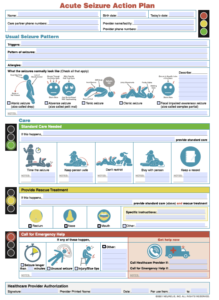What is a seizure cluster?
The definition of a seizure cluster varies from one individual to another, but in general, the term refers to a group of seizures occurring over a number of hours in a way that differs from an individual’s usual seizure pattern. For one patient, having three seizures over the course of two hours may represent a seizure cluster, while for another a seizure cluster may be dozens of seizures over a few minutes. Adverse effects of seizure clusters include risk of injury from the seizures themselves, prolonged recovery time after seizures, and missed work, school, or social activities. Seizure clusters may progress into status epilepticus.
What is status epilepticus?
The official definition of status epilepticus has evolved over time, but the term generally refers to a prolonged seizure that may not stop on its own without intervention. The most recent definition presented by the International League Against Epilepsy identifies generalized convulsive (tonic-clonic) status epilepticus as a seizure lasting longer than five minutes, with an increased risk of brain injury if the seizure continues for 30 minutes or longer. For other seizure types, such as focal or absence seizures, these time points may be more prolonged.
The majority of seizures in individuals with LGS are short and terminate on their own in less than two to three minutes. However, if status epilepticus occurs, it is a medical emergency that may result in severe consequences if not treated rapidly.
What is Non-Convulsive status epilepticus?
Nonconvulsive status epilepticus (NCSE) is a prolonged seizure that looks like altered mental status as opposed to the dramatic convulsions seen in generalized tonic-clonic status epilepticus. There are 2 main types of NCSE.
- In the first type of NCSE, patients are confused or behaving abnormally and appear to be having a non-stop absence (petit mal) seizure or a non-stop focal impaired awareness (complex partial) seizure.
- The second type of NCSE is subtle and occurs after a long generalized tonic-clonic seizure. The person will have continuous subtle motor jerks, especially of the face or hands, and this persists over time. Brain damage can occur if not treated.
What causes seizure clusters and status epilepticus?
People with intractable epilepsy (seizures that are not controlled by medication) are at higher risk for having seizure clusters or status epilepticus, but these episodes may also occur in people whose seizures are usually well controlled.
Some common triggers for seizure clusters or status epilepticus include:
- Illness
- Missed antiseizure medication doses
- Sleep deprivation
- Stress
- Having a Developmental and Epileptic Encephalopathy (DEE), such as LGS
For some women, seizure clusters may occur in relation to their menstrual cycle. However, seizure clusters or status epilepticus may also occur without an apparent trigger. Keeping a seizure diary may be helpful in identifying seizure patterns triggers.
How can seizure clusters and status epilepticus be treated?
Prompt treatment of seizure clusters and status epilepticus is important in limiting the duration of seizures and may prevent the need for more intensive hospital-based treatment.
Medications to treat seizure clusters or status epilepticus are often called rescue medications. Several rescue medications are now available for out-of-hospital treatment. All of these medications are part of the benzodiazepine group of drugs, which are the first choice for treatment of prolonged seizures in the hospital. While benzodiazepines used in the hospital are usually given intravenously (IV), benzodiazepine medications available for out-of-hospital treatment may be given orally, rectally, or nasally.
All benzodiazepines have the same potential side effects, which include drowsiness, dizziness, and impaired coordination. At high doses, they may cause respiratory depression. In general, emergency services should be contacted after administration of any of these medications to provide assistance if the seizure continues or if serious adverse effects occur.
Rescue Medications
See Rescue Medication Video Demonstrations >
When should rescue medications be used for seizure clusters or status epilepticus?
Every person with LGS and epilepsy should develop a Seizure Action Plan (SAP) with his or her medical provider that details the indications for use of a seizure rescue medication and which medication should be used. You should implement this plan as soon as possible once you identify a seizure cluster or status epilepticus (seizure lasting longer than 5 minutes). You should document the plan and ensure it’s accessible to anyone with the individual during a seizure. For individuals with frequent seizure clusters or status epilepticus, an emergency plan should be available for medical personnel. Most schools and daycare providers require a written Seizure Action Plan for all children with epilepsy that details the types of seizures they have, what should be done if they have a seizure, and when rescue medications should be given.
How do I create a Seizure Action Plan?
- Download a Seizure Action Plan Template
- Consult your medical provider to decide when and which seizure rescue medication to use.
- Share your Seizure Action Plan with anyone who might be with your loved one when they experience a seizure.
Download a Seizure Action Plan PDF
- You can find more SAP examples at:
Thank you to the TSC Alliance for the use and adaptation of the above article, which was co-written by Derek Bauer, MD, the University of Virginia at Charlottesville, and Laura Jansen, MD, PhD, Washington University St. Louis.
For Physicians
Seizure Clusters: Practical Aspects and Clinical Strategies to Care for Patients in the Community.
- Seizure Clusters: Practical Aspects and Clinical Strategies to Care for Patients in the Community.
- Recognizing seizure clusters in the community: The path to uniformity and individualization in nomenclature and definition
- Consequences: Bench to home
- Introduction to use of an acute seizure action plan for seizure clusters and guidance for implementation
- Rescue therapies for seizure clusters: Pharmacology and target of treatments
- Economic aspects of treating seizure clusters
- Future opportunities for research in rescue treatments
Updated 10/16/24 (SC)

